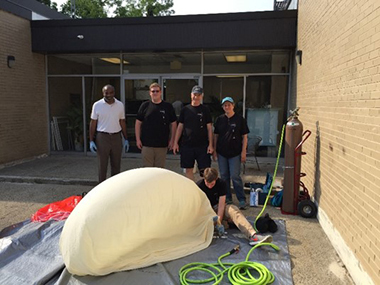Protecting Our Air Quality
Atmospheric Sciences Research Center Students and Faculty Spend Summer Launching Weather Balloons over the Long Island Sound
 |
|
From left: Everette Joseph, ASRC Director, Christopher Conover ’18, Jim Schwab, ASRC Senior Research Associate, Janie Schwab, ASRC Research Technician, Brennan Stutsrim, DAES senior |
ALBANY, N.Y. (August 28, 2018) – Despite improvements, air pollution in New York City continues to pose significant health risks to not only the millions of people living within the Big Apple, but also those living downwind along the shorelines of the Long Island Sound in New York, Connecticut and, at times, as far east as Rhode Island and Massachusetts.
It’s an issue that Brennan Stutsrim is dedicating his summer break to better understanding.
Stutsrim, an incoming senior in the Department of Atmospheric and Environmental Sciences (DAES), is participating in a field study to investigate how unhealthy levels of near ground-level ozone, better known as smog, form in the Metropolitan area and drift northeast over the Long Island Sound.
The LISTOS Study:
Led by the Northeast States for Coordinated Air Use Management (NESCAUM), with support from the New York State Energy Research and Development Authority (NYSERDA), the Long Island Sound Tropospheric Ozone Study (LISTOS) involves researchers from state and federal agencies, along with faculty and students from more than a half dozen colleges and universities. The group is combining satellite, aircraft, balloon, marine and ground-based methods to obtain unprecedented air quality measurements at locations surrounding the Sound’s shorelines.
Stutsrim is one of several UAlbany students involved with the study, along with faculty researchers in the University’s Atmospheric Sciences Research Center (ASRC).
“Air pollution meteorology is something I’ve been interested in learning more about,” Stutsrim said. “One of my professors, Ross Lazear, emailed me the application for this field study, and I immediately knew it could be a great opportunity to do hands-on research before graduate school. You’re not going to get this experience inside a classroom.”
.png) |
|
Christopher Conover ’18 prepares to launch a weather balloon over the Long Island Sound.
|
A large portion of ASRC’s cohort is focused on the balloon measurements, launching a lightweight, weather balloon-borne instrument – also known as an ozonesonde – into the atmosphere. As the balloon rises, it collects information on ozone levels and other standard metrological quantities before bursting at about 115,000 feet.
In addition, DAES graduate student Jie Zhang is operating a ground-based mobile lab to measure emissions of ozone precursor gasses.
NASA, the University of Maryland and Stony Brook University are flying aircraft equipped with sensor instruments, while the Environmental Protection Agency is leading the project’s ground and satellite work.
The agencies coordinate daily to determine to take their measurements. ASRC’s balloon researchers are “on call,” launching from a set location at Stony Brook University’s Flax Pond Marine Laboratory – sometimes during wee hours.
“It can take between three and seven days to prepare the balloon instrumentation, so we are constantly monitoring long-term air quality forecasts to determine when the highest levels of ozone might hit the Flax Pond region. Even if it’s at midnight,” said Christopher Conover ’18, an alumnus of DAES’ undergraduate program. “Once the balloons are up in the air we start tracking the data in real-time.”
“Right now we are focused on collecting the data,” added Department of Physics graduate student Bhupal Shrestha. “Once the project is completed we will be comparing our measurements with the other collection methods to look at long-term trends and make recommendations that can help improve the region’s air quality.”
A Better Future:
Data collection will continue through September with plans for a workshop in early 2019 to discuss the project and its findings.
ASRC researchers will also compare the project’s measurements with data from the New York State Mesonet’s three weather stations on Long Island. Headquartered at UAlbany, the NYS Mesonet is an advanced network of 126 standard weather stations across the state, with at least one site in every country and borough. The stations measure the local temperature, humidity, wind speed and direction, pressure, radiation and soil information.
“LISTOS will help officials in New York State understand how to improve air quality and ultimately protect public health,” said ASRC Director Everette Joseph. “I am proud that, through our excellent students, scientific expertise, and resources such as the state's mesonet network, we will be able to help New York be a leader in protecting the environment. At UAlbany, we are serving dual purposes of preparing our students with valuable hands-on experience in advance research and technology, while also serving the state and general public.”
“It’s really important that we have students with a meteorology background who are interested in air pollution research,” said Jim Schwab, a senior research associate at ASRC. “These are the next generation atmospheric scientists who are going to solve some of the most pressing challenges in our field. It’s a good thing for all of us to have them involved with this project.”
You can learn more about the LISTOS project and participating agencies here.
![]() For more news, subscribe to UAlbany's RSS headline feeds
For more news, subscribe to UAlbany's RSS headline feeds
A comprehensive public research university, the University at Albany-SUNY offers more than 120 undergraduate majors and minors and 125 master's, doctoral and graduate certificate programs. UAlbany is a leader among all New York State colleges and universities in such diverse fields as atmospheric and environmental sciences, business, education, public health,health sciences, criminal justice, emergency preparedness, engineering and applied sciences, informatics, public administration, social welfare and sociology, taught by an extensive roster of faculty experts. It also offers expanded academic and research opportunities for students through an affiliation with Albany Law School. With a curriculum enhanced by 600 study-abroad opportunities, UAlbany launches great careers.


